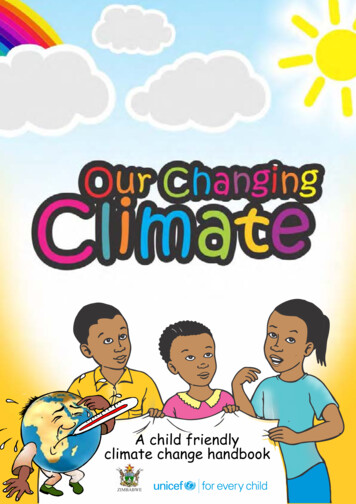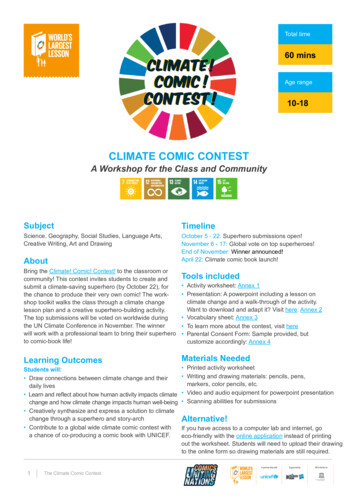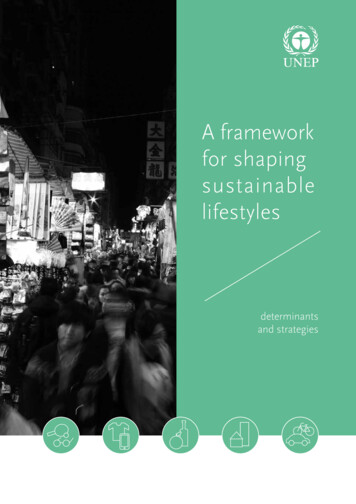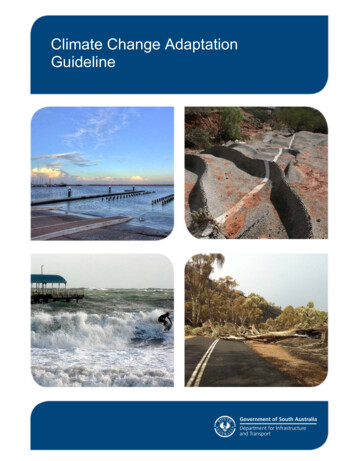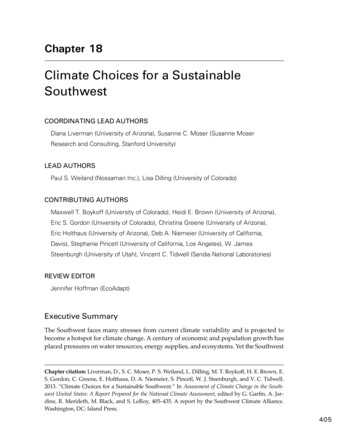
Transcription
Chapter 18Climate Choices for a SustainableSouthwestCoordinating Lead AuthorsDiana Liverman (University of Arizona), Susanne C. Moser (Susanne MoserResearch and Consulting, Stanford University)lead authorsPaul S. Weiland (Nossaman Inc.), Lisa Dilling (University of Colorado)contributing authorsMaxwell T. Boykoff (University of Colorado), Heidi E. Brown (University of Arizona),Eric S. Gordon (University of Colorado), Christina Greene (University of Arizona),Eric Holthaus (University of Arizona), Deb A. Niemeier (University of California,Davis), Stephanie Pincetl (University of California, Los Angeles), W. JamesSteenburgh (University of Utah), Vincent C. Tidwell (Sandia National Laboratories)review editorJennifer Hoffman (EcoAdapt)Executive SummaryThe Southwest faces many stresses from current climate variability and is projected tobecome a hotspot for climate change. A century of economic and population growth hasplaced pressures on water resources, energy supplies, and ecosystems. Yet the SouthwestChapter citation: Liverman, D., S. C. Moser, P. S. Weiland, L. Dilling, M. T. Boykoff, H. E. Brown, E.S. Gordon, C. Greene, E. Holthaus, D. A. Niemeier, S. Pincetl, W. J. Steenburgh, and V. C. Tidwell.2013. “Climate Choices for a Sustainable Southwest.” In Assessment of Climate Change in the Southwest United States: A Report Prepared for the National Climate Assessment, edited by G. Garfin, A. Jardine, R. Merideth, M. Black, and S. LeRoy, 405–435. A report by the Southwest Climate Alliance.Washington, DC: Island Press.405
406assessment of climate change in the southwest united statesalso has a long legacy of adaptation to climate variability and of environmental management that has enabled society to live within environmental constraints and to protectlarge parts of the landscape for multiple uses and conservation. Many different types oforganizations and individuals in the Southwest have already taken a variety of steps torespond to climate change; and a wide range of choices are available for those choosingto reduce greenhouse gas (GHG) emissions or implement preparedness and adaptationmeasures to manage the risks from climate variability and change in the region. Othersare pursuing energy and water efficiency, renewable energy, or sustainable agriculturefor other reasons but these can also reduce emissions or assist with adaptation.This chapter features the following key findings: The U.S. Southwest is a region with great capacity both to respond to environmental stress and to steward its abundant natural resources. Past efforts todevelop its water resources and protect its public lands are indicative of thiscapacity, and while viewed as successes by many, they also illustrate challengesand trade-offs in policy and actions that can increase resilience for some whileincreasing vulnerability for others. (medium-high confidence) Local and state governments, tribes, private-sector entities, non-profit organizations, as well as individuals are already taking steps to reduce the causes ofclimate change in the Southwest—though often not solely for climate-mitigationpurposes—and there are many lessons to learn from the successes and failuresof these early efforts. Few systematic studies have been undertaken to date toevaluate the effectiveness and impacts of the choices made in the Southwest toreduce GHG emissions. (medium-high confidence) If the Southwest decides to reduce a proportional share of the emissions recommended (50% to 80% by 2050) by the U.S. National Academy of Sciences andothers, the carbon budget for the region between 2012 and 2050 would only be150–350 million metric tons per year (NRC 2010d). This would be a very challenging but not impossible target to meet. (medium-low confidence) There are low-cost, cost-saving, or revenue-generating opportunities for emission reductions in the Southwest, especially in energy efficiency and renewableenergy. (medium-high confidence) A range of stakeholders are already planning how to prepare for and respondto climate risks in the Southwest, but few have begun implementing adaptationprograms due to financial, institutional, informational, political, and attitudinalbarriers. Various adaptation options exist in every sector, including many thathelp society respond to current risks of climate variability and extreme events.(medium-high confidence) Many response options simultaneously provide adaptation and mitigation “cobenefits,” reducing the causes of climate change while also increasing the preparedness and resilience of different sectors to climate change. Other responseoptions involve trade-offs between increasing emissions or reducing resilience
Climate Choices for a Sustainable Southwest More research and monitoring is needed to track and evaluate decision outcomes and to understand the balance and effectiveness of these choices especially under financial constraints. (high confidence)18.1 IntroductionThis chapter provides an integrated overview of solutions and choices for respondingto climate change in ways that reduce risks and support sustainable development inthe Southwest. The goal is to illustrate the range of choices for responding to climatechange, along with some of the relevant trade-offs and opportunities, to inform policyoptions and decisions. In the context of climate change, risk reduction includes: reducing global GHG emissions to limit global changes; limiting activities locally or regionally (e.g. land use choices) that increase unwanted local or regional climatic changes;taking action now to accommodate and adapt to climate changes to date; and increasingcapacity to respond effectively and adapt to future changes.The chapter begins with a discussion of how the Southwest might choose to securea sustainable future in the context of climate change. The Southwest has a long historyof adapting to environmental stresses and managing resources, which demonstrate theability of the region to make choices that promote sustainability of ecosystems and natural resources, the economy, and society, but also to minimize some of the risks.Because some studies have identified the Southwest as a potential hotspot of climatechange (see Chapter 5) where changes may start to occur rapidly or unfold particularlyseverely, this chapter also examines some of the options for transformational adaptationto climate change—rather than make more incremental adjustments to climate risks—in the event it becomes necessary to make significant changes in resource allocation ortechnology, or to relocate people, ecosystems and infrastructure. The co-benefits andtrade-offs in linking mitigation and adaptation are also discussed.National choices about responding to climate change were recently presented by theNational Research Council’s America’s Climate Choices study (NRC 2010a, 2010b, 2010c,2010d). This study is used as a starting point for identifying some of the options forlimiting emissions and adapting to climate change, and analyzing what these optionsmight mean for the Southwest in terms of social, technological, economic, behavioral,and institutional structures and choices.The chapter also reviews some of the choices and solutions that are already beingimplemented in the Southwest in response to climate change. These efforts include: regional activities by federal agencies; the plans and activities of states, cities, and communities; key regional collaborations such as those in major river basins; and solutions thathave been chosen by businesses, tribes, and civil society organizations.Finally, we discuss options for integrating mitigation and adaptation activities inways that mutually support each other, rather than produce difficult trade-offs, and focus on the challenges communities and organizations face in planning and implementing solutions. We also raise the question of what actions may be needed if both globalmitigation and regional adaptation fail to minimize climate change and resulting impacts to acceptable levels.407
408assessment of climate change in the southwest united states18.2 Defining a Sustainable Approach to Climate Change inthe SouthwestFor the purposes of this chapter, a “sustainable” Southwest is defined as one where thechoices we make in responding to climate change assist in the long-term maintenance ofeconomic, social, and environmental well-being―in other words, in meeting the needsof the present without compromising future generations (Wiek et al. 2012). These choicesinclude reducing the risks of climate change by limiting emissions and making it easierto adapt to the impacts of climate changes that are occurring or will occur. Sustainablesolutions endure in the face of continuing climate change and other stresses. The Southwest alone cannot mitigate all global GHG emissions, but the region can choose frommany options to reduce its proportional contribution to the global causes of climatechange and reduce the region’s own vulnerability to climate change.Climate change is not the only threat to sustainability in the Southwest, so pathwaysto sustainability involve managing multiple risks to the region. This requires considering not just environmental, economic, and social goals, and addressing climate mitigation and adaptation, but also managing risks and opportunities for the well-being of theregion’s residents and the Earth system (MacDonald 2010). The best pathways will bethose that maximize the benefits for environment, economy, and society while minimizing costs and environmental risks, especially for the most vulnerable. One of the greatestchallenges is to be prepared for and able to act in the face of uncertainty while beingaware of the possibility of reaching thresholds where conditions deteriorate rapidly(Lempert and Groves 2010; Westley et al. 2011). A sustainable Southwest will need earlywarning of such risks and plans for responding if and when they occur.18.3 Making a Sustainable Living in the Southwest: Lessonsfrom HistoryThe history of the Southwest demonstrates a remarkable ability to adapt to the climaticand geographic extremes of the region. Tapping into this ability is key to developingsustainable solutions to future climate change.Throughout human history, water—in particular the ability to move it across thelandscape—has been critical to the growth of societies (Worster 1992). Many of the prehistoric peoples of the Southwest found ways to harvest rainwater and runoff and evendeveloped sophisticated water conveyance systems and other techniques for living in adesert climate. The European settlers who came later established water infrastructureand institutions for the development of cities and agriculture. The development of waterresources is one of the most notable stories of settling and living in the Southwest. Key tothe rapid population expansion in the Southwest was the construction of massive waterprojects, especially following the passage of the federal Reclamation Act of 1902 (Hundley 1991) (Figure 18.1). By taming the highly variable flow of rivers such as the Coloradoand Rio Grande and creating a vast network of canals and ditches capable of movingwater between basins, settlers and the federal government did more than just adapt tothe necessities of life in an arid climate―they made it a thriving corner of the nation.
Climate Choices for a Sustainable SouthwestFigure 18.1 Water resource development in the Southwest: 2005 surface-water withdrawals for irrigation and dams. The massive development of water resources stands as one of thegrand stories of settling the Southwest. Although this has created its share of environmental and socialproblems, and there are legitimate questions as to the long-term sustainability of water supply interventions, the systems of dams (shown here), diversions, and management institutions is a testament tothe region’s ability to invest in managing its environment for economic and social well-being. In light ofthese incredible efforts to make the Southwest habitable, meeting the new climate challenges of thetwenty-first century seems less daunting. Map from The National Atlas of the United State of America(http://www.nationalatlas.gov; see also http://www.nationalatlas.gov/mapmaker?AppCmd CUSTOM&LayerList wu2005%3B5&visCats CAT-hydro,CAT-hydro; accessed October 8, 2012).Water development in the West certainly also created a number of environmentaland social problems, and there are legitimate questions as to the long-term ecological,social, and economic sustainability of water demand and use in the region. Fundamentalchanges to the natural flow of water have had profound consequences for the naturalenvironment. The waters of the Colorado River now rarely reach its mouth at the Gulfof California, drying up a critical and unique wetland (Glenn et al. 1996). The complexplumbing of the Central Valley Project and the State Water Project in California haschanged fish communities, water quality, and habitat structure in the Sacramento-SanJoaquin Delta (Nobriga et al. 2005). Water availability allowed for massive increases inpopulation throughout the West, in turn increasing the vulnerability of population centers to drought and increased competition between water users (Reclamation 2005).Despite these consequences, the settlement and watering of the Southwest stands asa reminder of the remarkable effort and funds mustered to transform a dry landscapeinto one with booming urban centers and extensive and productive agricultural lands.A second example of choices that created a more sustainable Southwest were thedecisions of federal, state, and local governments, as well as private landowners and409
410assessment of climate change in the southwest united statesconservation groups, to set aside vast areas of the West to conserve extractive commodities such as timber and protect scenic beauty, wildlife, habitat, and open space. Twentytwo national parks, nearly 66 million acres of national forests, 74 wildlife refuges, andother protected areas cover more than 165 million acres of the Southwest, conservingnatural resources, and providing income to users such as ranchers, loggers, miners, andtourist operators and recreation to millions of residents and tourists (Clawson 1983;Wilkinson 1992) (see also Chapter 3, Section 3.1.3). The Southwest is also home to 120million acres under the jurisdiction of the Bureau of Land Management (Figure 18.2).While the vast majority of federal public lands were originally created to conserve natural resources for uses in the public interest, such as timber and grazing lands, an environmental protection movement in the 1960s and 1970s led to stronger laws, guidingthe management and protection of public lands, and also recognized a number of nonutilitarian uses for the federal domain (Hardt 1994). The Wilderness Act of 1964, Wildand Scenic Rivers Act of 1968, Endangered Species Act of 1973, National Forest Management Act of 1976, Federal Land Policy and Management Act of 1978, and a host of otherlaws and regulations helped ensure that public lands could be managed and conservedfor years to come and that biodiversity would be protected.This federal land ownership system, which covers nearly 30% of the entire UnitedStates (Loomis 2002), helps protect habitat and ecosystem services, facilitates sustainablemanagement of resources, and provides an “insurance policy” for climate adaptation,as land-based resources and economies (such as forestry, tourism, and recreation) aswell as species and ecosystems consequently have significant space to migrate to andadjust to the changing conditions. As federal climate-change adaptation response becomes increasingly coordinated, this large area of land can be managed for adaptationand multiple uses in an integrated fashion although multiple jurisdictions can presentsome barriers.As with water development, protection of public lands has its challenges. Extractive users, ranchers, recreationalists, and environmentalists struggle with each other andwith land-management agencies over appropriate uses of these areas. Yet the wealth ofpublicly owned land across the United States, especially in the Southwest, is a testamentto the willingness of Americans to take proactive steps to prevent the exploitation ofresources for the benefit of current and future generations: a sign of a spirit more thancapable of tackling the challenges of future climate change.The Southwest is also leading the economic transformation that has become knownas the “green economy,” with investments in business ventures that increase energysecurity, promote sustainability, and reduce environmental impacts (Jones 2009). Colorado and California in particular have supported moves to a green economy where jobsand profits are associated with renewable energy. Colorado has targeted public policy atgreen energy, attracting venture capital to clean technology of 800 million, and hostingan estimated 17,000 green jobs (see Box 18.5). In Colorado, New Mexico, and Utah, greenjob growth has outpaced overall job growth (Headwaters Economics 2010). In California, Roland-Holst (2008) estimates that energy efficiency has already generated incomesavings and created 1.5 million jobs, while redirecting consumption to in-state supplychains. He further estimates that AB 32 (the California Global Warming Solutions Act)will encourage innovation, increase income, and create more than 400,000 new jobs.
Climate Choices for a Sustainable SouthwestFigure 18.2 Extensive federal lands in the Southwest: A legacy for the future. T his mapillustrates the legacy of federal land ownership in the Southwest, covering nearly 30 percent of theentire United States. Protected habitat and ecosystem services ensure sustainable managementof resources and may be the greatest insurance policy against losses in the future, because naturalresource use and biological species can more easily adapt to rapidly changing climatic conditions.Modified from The National Atlas of the United States of America (http://www.nationalatlas.gov; seealso ands/fedlands3.pdf; accessed October 8, 2012).Other examples of sustainable choices in the Southwest include those cities andcommunities that have broken with the western model of sprawl, energy-intensivebuildings, and dependence on the automobile, to plan more sustainable communities.Sustainable urbanism in the Southwest has included downtown infill, dry landscaping, water reuse, renewable energy development, green-building standards, and publictransport to reduce water and energy use, protect green space, and create more livablecities (see, for example, http://www.lgc.org/freepub/healthy communities/index.html;Garde 2004; Farr 2007; and Chapter 13). Examples of large developments focused on anew sustainable urbanism in the region include Mesa Del Sol, New Mexico; Civano inTucson, Arizona; Stapleton, Colorado; Mountain House in San Joaquin County, California; and Santa Monica, California.18.4 Limiting Emissions in the SouthwestTo keep human-caused climate change below dangerous levels, the National ResearchCouncil (2010d) suggested that the United States and other industrial countries shouldreduce GHG emissions by 50% to 80% by 2050 compared to 1990 levels. This wouldgive a reasonable chance of keeping atmospheric GHG concentrations below 450 partsper million and limiting overall temperature increases to 3.6 F (2 C) above preindustriallevels. Because annual U.S. carbon dioxide emissions in 1990 were estimated to be 6411
412assessment of climate change in the southwest united statesgigatons (Gt), a 50% reduction by 2050 would mean reducing emissions to 3 Gt a year,and an 80% cut would be to 1.2 Gt. The NRC estimated that this gives the United Statesa total carbon budget of 170 Gt to 200 Gt for 2012 to 2050. (The study relied on a widerange of peer reviewed studies and estimated 2008 U.S. emissions to be the equivalent ofabout 7 Gt of carbon dioxide.) While its recommendation is highly ambitious and challenging, the NRC believes achieving this goal is possible, and more easily so if begunimmediately. The study also offers a basket of options for reaching this goal, includingchoices such as: putting a price on carbon; increasing the energy efficiency of electricity production and transport; moving toward low carbon fuels; increased research anddevelopment for carbon capture and storage and new-generation nuclear power generation; and the retirement or retrofit of emission-intensive infrastructure (NRC 2010c, 4–5).The latest emissions data for CO2 from fossil fuels in the Southwest shows the regionis responsible for 13.4% of the U.S. total in 2009, dominated by emissions from California, which ranks second to Texas in overall emissions (see also Chapter 12). The recentlyreleased GHG data reported by large facilities (EPA 2012a) shows that the largest emitters in the Southwest are power-generating plants and oil refineries, with only thirty facilities producing 50% of the emissions from all large facilities (EPA 2012b) (Table 18.1).Table 18.1 Greenhouse gas emissions by state in the Southwest, shownas CO2 equivalent emissions (in million metric tons [MMT])CO2 emissions inMMT (2009)Percent of RegionPercent of do9312.811.72Nevada405.510.74New 7—100StateU.S. totalSource: ies/ghg-inventory.html.Since data for projections of regionally specific carbon emissions scenarios are notavailable, an estimate of possible regional emission reductions is provided based on theNRC study cited above (NRC 2010d). Assuming global “business-as-usual” emissionswere to increase at 3% per year as assumed in several studies (Nakićenović and Swart2000; Garnaut 2008), the Southwest would have emissions of about 1,000 million metric
Climate Choices for a Sustainable Southwesttons (MMT) in 2020 and 2,400 MMT in 2050.i Alternatively, using the lower observedU.S. emissions growth rate of 1.2% per year (1990 2007) ), the region would have emissions of around 810 MMT in 2020,and approximately 1,090 MMT in 2050.For the Southwest to contribute its fair share to reducing emissions by 2050, as NRCrecommends, the region would need to reduce emissions to about 150 MMT to 350MMT per year by 2050. Since this is much lower than projected business-as-usual emissions discussed above―as much as a 90% cut by 2050―we conclude that meeting higheremission reduction goals in the Southwest would be very challenging, but not impossible. Any delay in beginning serious emission reductions would make achieving theregion’s goal of reducing its proportional share that much harder.Of the states in the region, only California and Colorado have made commitmentsto reduce their emissions in line with the 50% to 80% reduction recommended by theNRC. California’s goal is to reduce emissions by 80% below 1990 levels by 2050 (Stateof California, Executive Order S-3-05) and Colorado’s is to reduce to 80% below 2005levels by 2050 (State of Colorado, Executive Order D-004-08). Other states have mademore modest or non-binding emission reduction commitments―for example, throughthe 2007 Western Climate Initiative’s target of 15% below 2005 levels by 2020―but someof these commitments have been rescinded or not implemented (http://www.c2es.org/states-regions).Significant emission reductions can be made at low cost or can save money (see Chapter 12). One estimate for the United States showed that significant emissions reductionscould be achieved at a cost of less than 50 per ton of avoided emissions and that almosthalf of these reductions would actually involve money savings especially from energyefficiency (McKinsey 2007) (Figure 18.3). Many of the money-saving options are relevantto the Southwest and are already being implemented through individual and corporatechoices or through government incentives and regulation (see, for example, case studies of local communities at http://www.lgc.org/freepub/energy/index.html). Options include reducing overall energy consumption by driving less or adjusting thermostats,more efficient lighting, more efficient electronic equipment, building insulation, moreefficient automobiles, power plant retrofits, and methane management at mines. California has adopted many energy-efficiency strategies over the past several decades, and itseconomy grew by 80% between 1960 and 2008, with no change in per capita electricityuse and a savings of 1,000 per household (Kammen, Kapadia and Fripp 2004; Engeland Kammen 2009; Wei, Patadia, and Kammen 2010).Some researchers also suggest that the Southwest has a comparative advantage andreal opportunities in certain areas of emission reductions, which include solar energy,energy-efficiency savings, and low-carbon electric vehicles (Zweibel, Mason, and Fthenakis 2008; Fthenakis, Mason, and Zweibel 2009). New commercial installations of solarconcentrating or solar photovoltaic facilities have been located in the Southwest or areunder review in California, Colorado, Arizona, and Nevada. These states lead the country with installed solar photovoltaics and concentrated solar (Gelman 2010). The combination of ample cloud-free days and large areas of land, including abandoned industrialsites, farmland, and public land, represent a regional opportunity for this energy supply. Large solar facilities are not without controversy, however, as they can displace native species, disturb the soil, and may conflict with other human uses of the land.413
414assessment of climate change in the southwest united statesFigure 18.3 McKinsey Mitigation Cost Curve. G overnments, for-profit and non-profit organizations,and individuals are already taking steps to reduce the causes of climate change in the Southwest.Many low-cost or negative-cost opportunities for emission reductions (particularly energy efficiency andrenewable energy) are available. This well-known graphic shows a wide range of actions that incur costsavings (with “negative costs” shown on the left side of the graphic with bars extending below thehorizontal line). Actions to the right of the graphic incur increasingly higher costs. The width of each barassociated with a particular action indicates how much carbon could be abated in 2030 throughout theUnited States if it were implemented fully (in gigatons of carbon per year). Graph based on McKinsey(2007).18.5 Adaptation Options in the SouthwestMany of the chapters in this report show that impacts of climate change are not onlyexpected to occur in the future, but are already beginning to manifest across the Southwest. This implies that reducing emissions (i.e., mitigation) cannot be the only responseto climate change. Efforts are now also required to prepare for, plan for, and minimizethose impacts that cannot be avoided and turn expected climate changes into opportunities wherever possible (i.e., adaptation).ii
Climate Choices for a Sustainable SouthwestBox 18.1Case Studies of Climate Choices for a Sustainable SouthwestFederal Lands and Agency Planning in the SouthwestFederal land and resource management agencies are beginning to incorporate climate changeconsiderations into planning, although effortsare not consistent across agencies (Jantarasami,Lawler, and Thomas 2010). A 2009 SecretarialOrder issued at the Department of the Interiorspurred individual agencies to begin to incorporate adaptation into individual decisions. TheNational Park Service’s Climate Change Response Program aims to protect park resourcesfrom climate change impacts while also usingparks to develop knowledge about ecosystemimpacts from climate change. A survey of federalland managers in three states in 2011 (Colorado,Wyoming, and Utah) showed that only 6% oftheir offices were carrying out adaptation plans,but another 25% percent were in the process ofdeveloping plans (Archie et al. 2012). A majority were either not currently planning for climatechange adaptation (47%) or did not know the status of adaptation planning in their office (24%).Preliminary data indicate that there is some difference in the level of planning among agencies,with the U.S. Fish and Wildlife Service planningat a significantly higher rate than its sister agencies, but it is too early to say why this may be thecase. The National Park Service has adopted arange of actions to meet the challenges of climatechange in the Southwest region including effortsto reduce energy consumption with a goal of carbon neutrality and through the Climate FriendlyParks program which provides parks with toolsto address climate change, including emissionsinventories, action plans, and outreach support.This section focuses on adaptation and basic approaches to it and provides examplesof activities already being undertaken. America’s Climate Choices (NRC 2010a) providesa starting point to lay out a fundamental way of thinking about adaptation to climatechange. In it, adaptation is essentially viewed as a challenge in risk management. TheSouthwest is no stranger to climate-related risks, such as drought, heat extremes, floods,high-wind storms, wildfires, heavy snowfall in the mountains, and cold snaps (Chapters 4, 7, and 8). To reduce the risks from these events in the past, the region’s residents,businesses, and planners devised a number of mechanisms, including early warningsystems, emergency planning, irrigation systems, building codes, and insurance policies. As the historical patterns of extreme weather events change with a warmer, drierregional climate, the Southwest will need these and additional risk-management toolsto prepare for the future so that disruptive events do not become disasters.Risk management in the face of an uncertain future climate―as defined and discussed in detail in America’s Clim
18.2 Defining a Sustainable Approach to Climate Change in the Southwest For the purposes of this chapter, a “sustainable” Southwest is defined as one where the choices we make in responding to climate change assist in the long-term maintenance of economic, social, and envi





